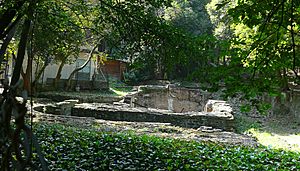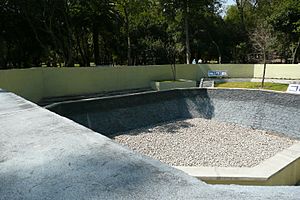Baths of Chapultepec facts for kids

The Baths of Chapultepec were a series of pools and channels. They were used for a very long time, from ancient times before the Spanish arrived (the pre-Columbian period) until the early 1900s. These baths collected water from the natural springs on Chapultepec Hill. This water was super important because it provided clean drinking water to Mexico City. Today, you can still see parts of these old baths, like the famous Baths of Moctezuma, which was recently fixed up. There are also remains of colonial-era baths near Well 5, also known as Manantial Chico, in Chapultepec.
Contents
A Look Back: History of the Baths
When the ancient city of Tenochtitlan started to grow, its people needed more water. In 1381, the Aztec ruler Chimalpopoca asked his grandfather, Tezozomoc, for permission. Tezozomoc was the ruler of Azcapotzalco. Chimalpopoca wanted to use the water from Chapultepec's springs for his city. Tezozomoc agreed, and so the Aztecs began building an aqueduct (a water bridge).
Building the Aqueduct
The first aqueduct built by the Aztecs wasn't very good. This problem with water was one reason for a big war. Tenochtitlan teamed up with Texcoco to become the most powerful city in the Valley of Mexico. Later, they formed the Aztec Triple Alliance.
Chapultepec Hill had many springs, mostly on its south side. In 1466, the Texcocan ruler Nezahualcoyotl led a project to improve the water system. They built canals and reservoirs (water storage areas). These were the "baths" that helped raise the water level and pressure in the aqueduct. This also allowed them to water the Chapultepec Forest.
Spanish Arrival and Changes
During the Spanish attack on Mexico City, Hernán Cortés ordered some of these baths to be destroyed. He also took control of the area. This left the city without clean drinking water.
After the Spanish took the city, Cortés decided to make it the capital of New Spain. He ordered the baths to be rebuilt. Over time, these baths were changed many times. They were often made higher, but this didn't always mean they held more water. By 1740, people noticed that the amount of water was decreasing. Because of this, the baths were completely closed in 1929.
What Remains Today
Today, one of the baths has been rebuilt. It's now an exhibition space with sculptures and maps. People often call it The Baths of Moctezuma. On the east side, near the monument to the 201 Squadron, you can see the remains of some colonial baths. You can even spot parts from the ancient pre-Columbian times there. Inside this area is Well Five of Chapultepec, which is still managed by the National Water Commission.
In their prime, the baths weren't just for drinking water. People could also get special permission to build private baths for irrigation (watering crops). There were even public baths where people could pay to use them.
What Were These Baths Like?
The baths were built using stone and lime. We only have information about three of the many baths that once existed. Their names were:
- Alberca Grande (Large Bath) or Alberca de los Llorones (Bath of the Weepers).
- Alberca de los Nadadores (Swimmer's Bath).
- Alberca Chica (Small Bath) or Alberca de Moctezuma (Moctezuma's Bath).
Alberca Grande
The Alberca Grande was located where the forest now meets Avenue of los Constituyentes. It was a rectangular pool, about 17.47 meters long and 1.39 meters wide. It was either 2.67 meters or 12 meters deep. This bath was used to water the Tacubaya area and belonged to a nobleman called the Count of Peñasco.
Alberca de los Nadadores
The Alberca de los Nadadores was even bigger but not as deep. It was located further east. This was the first public swimming bath or spa in Mexico City.
Alberca Chica or Moctezuma's Bath
The Alberca Chica or Alberca de Moctezuma was the highest bath in relation to Mexico City. It was probably the oldest one too. Water pipes for the aqueducts started from this bath. We know the years it was renovated: 1548, 1571, 1714, and 1870. This information comes from special markers found near a pump room next to the bath, which supplied water to the Castle of Chapultepec.
Each time it was rebuilt, the bath became smaller and taller. In 1974, archaeologists Ruben Cabrera, María Antonieta Cervantes, and Felipe Solís studied this bath. They found six boxes built inside each other, each one smaller than the last. The oldest one was very damaged but was about 15 meters long and square with rounded corners. Up to the fourth box, there were signs of baked brick, dating to 1870. The fifth and sixth boxes used cement. The last one, which could be seen before its reconstruction in 2010, had a concrete ceiling and glass. It was 5.70 meters on each side. There was an iron staircase, and a pump room was at its southern entrance.
See also
 In Spanish: Albercas de Chapultepec para niños
In Spanish: Albercas de Chapultepec para niños
- List of pre-columbian archaeological sites in Mexico City


